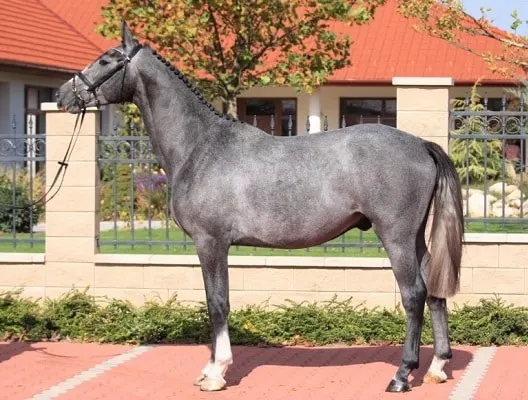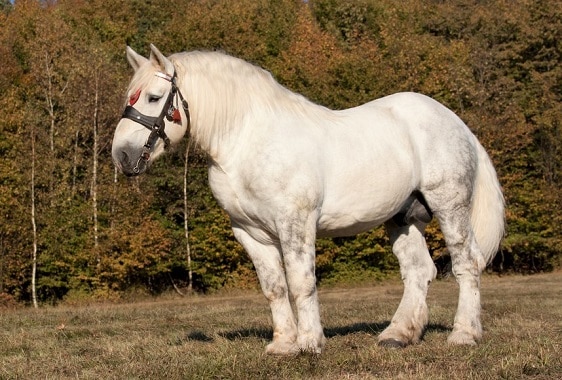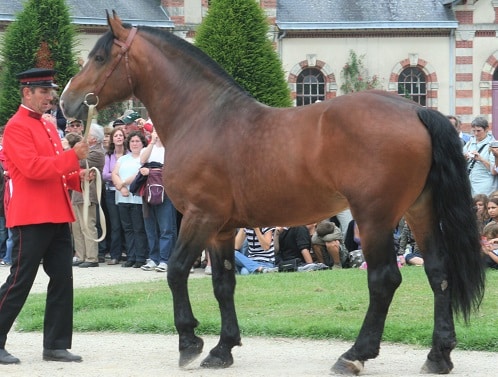French horse breeding has undoubtedly delivered high quality and standards over the past few centuries. Today, the industry is closely supervised by the French Institute of the Horse and Riding (IFCE).
Until recently, the French National Stud (Haras Nationaux) played a central role in many breeding programs all over the country. Across 24 stud farms, the institution offered a selection of prestigious Thoroughbred and harness racing stallions at an affordable stud fee.
Many modern French horse breeds trace back to the now extinct Anglo-Norman horse. This influential breed developed in the 19th century from Thoroughbred, trotter and local Norman stock. It later diverged into the French Trotter and Norman Cob and eventually merged with the Selle Français breed.
Other than its elite sports horses, France is also proud of its many draft and pony breeds.
Here are 8 of the most well-known French horse breeds!
Selle Français

The Selle Français is among the most elite showjumping horse breeds in the world. Riders of Selle Français horses have won multiple Olympic gold medals in show jumping and eventing. The world’s most expensive show jumper, Palloubet D’Halong, was also a Selle Français and sold for a record price of $12.8 million!
The Selle Français is a melting pot of several sport horse breeds, including the Anglo-Norman, French Trotter, Thoroughbred, and Anglo-Arabian. It became an official breed in 1958.
Due to its warmblood type, average height in the breed is over 16 hands, but can range from 15.1 to 17.3 hands. The Selle Français is blessed with strong hindquarters, a deep chest and sloping shoulders, making it the ultimate athlete.
These horses are generally bay or chestnut, rarely gray. The Selle Français is a popular horse breed for showjumping and eventing.
Camargue Horse

The Camargue is a French horse breed that has been roaming the Camargue marshlands since ancient times. Today, they are deeply ingrained in local culture and are also a popular tourist attraction.
The origins of the Camargue Horse are obscure. Some scientists believe they developed from the prehistoric Solutré horse native to the region. At a glance, their features indicate Arabian, Thoroughbred, and Barb influence.
The breed has rightfully earned its popular name “The Horses of the Sea”, often used by wildlife photographers. The Camargue Horse has adapted perfectly to its marshy environment with its low weight-to-height ratio and wide soles, designed to propel them forward in the water.
To this day, Camargue Horses roam the wetlands in semi-feral herds. Their coat color is always gray, which starts off a darker shade when they are young and becomes lighter as they age. Although members of the breed are fairly small (13.1-14.3 hands), these hardy horses are strong enough to carry an adult human.
Camargue horses serve as the mounts of the “gardians”, local cattle herders responsible for the management of livestock. Under saddle, they have proven to be talented riding horses and competed successfully in dressage and endurance riding.
Percheron

Vera Zinkova / Shutterstock.com
The Percheron is one of the most common French horse breeds in the world, with Percheron breeders found on nearly every continent. These gentle giants are famous for their elegant build and exceptional work ethic.
Most theories agree that Iberian horses had a major influence on the developing Percheron breed. Some argue that this role was filled by the heavier Boulonnais horse and that the two breeds might’ve even shared ancestry.
As the need shifted from heavy to light cavalry in the 18th century, more and more Percheron mares were bred with Arabian sires to produce the ideal army mount. Their influence comes across in the fine features and athletic build of the breed.
Exports of Percheron horses from France to the United States began in the late 19th century. As they grew in popularity, the horse breed soon made it to the United Kingdom, South America, and Australia. Although their numbers plummeted after the World Wars, the breed recovered quickly.
The official colors of the Percheron are gray and black, and their height ranges from 15.1 to an astounding 19 hands. Their warmblood crosses often produce high quality sport horses, while purebred Percherons make good driving, show jumping and police horses.
French Trotter

As France’s only trotting horse breed, the French Trotter dominates harness racing in the country. It originally developed from the crossing of Anglo-Norman and other trotting breeds. Besides sulky racing, the breed also takes part in ridden trotting races as well as various other disciplines.
The French Trotter was purpose-bred for harness racing in 19th century Normandy. Its foundation stock consisted mainly of Aglo-Norman, Standardbred, Norfolk Trotter, Thoroughbred and Hackney horses. Despite the Standardbred being a lateral pacing breed, the French Trotter retained its diagonal trot.
The breed became official in 1922, and until 1937 the society ran an open stud book. This meant that admission was open to all horse breeds, provided they met the selection criteria.
Although the French Trotter may not be as fast as its rival breed the American Standardbred, it can maintain a consistent speed for longer periods of time. French Trotters usually take longer to mature, but they generally have longer racing careers.
French Trotters are usually bay or chestnut in color and stand between 15.1 and 16.4 hands tall. Horses not fast enough for the racetrack often go on to have a career as a general riding, hunting, or showjumping horse.
Boulonnais

Another elegant and noble French draft horse breed is the Boulonnais. This mainly gray breed has a remarkably fine skin due to the influence of oriental blood, which gives these horses the look of polished marble. The Boulonnais also played a major role in the development of the Anglo-Norman horse, France’s most influential breed.
Early versions of the modern Boulonnais were present by the 17th century, although they didn’t form a cohesive breed. These subtypes were crossed with Iberian, Barb and Arabian bloodlines, creating the fine draft horses we see today.
A historic route from Boulogne to Paris was paved by Boulonnais mares during the 17th century. They belonged to a small subtype of the breed and regularly transported fish over 200 miles in just under 18 hours. Soon, The Boulonnais became a highly regarded powerhouse of French agriculture, transportation, and warfare.
Read more about ancient war horse breeds and their history here.
Similar to the Percheron, exports of large numbers of Boulonnais horses to the United States began in the early 19th century. Sadly, over the next hundred years, the breed drifted to the brink of extinction and is now a priority for conservation in France.
Breeding programs are currently underway to preserve these kind and unique horses. To increase the genetic diversity in the population, the National Stud has allowed the registration of third-generation Arabian and Boulonnais crosses. So far, breed numbers remain low with approximately 1,000 horses living in Europe.
Read more about the biggest horses and horse breeds here.
Norman Cob

The Norman Cob is a lightweight draft horse breed suitable for a wide range of riding and driving activities. The breed often represents its home country on international driving championships. Owners of Norman Cobs appreciate their calm temperament and willingness to work.
The breed takes its name from the region of Normandy in northwestern France. The area is also famous for producing other French horse breeds including the Percheron and French Trotter. The Norman Cob’s direct ancestor was the Carossier Normand, a breed developed from small local horses.
Historically, the Norman Cob was bred to be an all-around working horse. It played a role in French agriculture, pulled artillery during wartime, delivered mail and also performed on sporting events.
Compared to other cob breeds, the Norman Cob has a higher average height of 15.3 to 16.1 hands. Its body is compact but muscular, accompanied by a lively and elegant trot. The registry accepts bay, chestnut and seal brown horses and encourages white markings in the breed.
Norman Cobs are hardy horses able to live outdoors all year round. Their Thoroughbred ancestry has equipped them with great athleticism, useful in riding and driving competitions. The breed is a popular horse breed for beginner riders because of it docile nature and bombproof temperament.
French Saddle Pony

The French Saddle Pony is a relatively new breed that has only been around for a few decades. The idea was to create France’s own version of the ideal riding pony, similar to the existing British and German Riding Ponies. The breed has already shown its potential in English riding competitions and is growing in popularity outside France.
The French Saddle Pony developed in 1969 from a combination of British and French pony breeds, as well as Arabian and Thoroughbred bloodlines. The studbook opened in 1972 and closed 19 years later when the breed received its current name.
Because of the influence of multiple breeds, there isn’t yet a breed standard for the French Saddle Pony. Generally, the ponies are between 12.1 to 14.2 hands tall and can be of any color. They tend to have a slightly convex head and athletic body with strong legs and clean joints.
This sporty pony breed is intended for children and small adults to ride on dressage, show jumping and cross-country events. However, it is also ideal for pleasure riding or driving in harness.
The French Riding Pony can be found in riding school across France and it equally suits novice and advanced riders. Some ponies made it to international level competition and there is no doubt the breed has a bright future.
Breton

The Breton horse breed originates from the Breton mountains of the Brittany province in France. This heavy breed is still used for all kinds of draft work and has several different subtypes.
The ancestors of the Breton horse had lived in the region for thousands of years. They were the foundation stock that ultimately led to the creation of the breed, through the influence of several Oriental and European bloodlines.
The Breton’s role in society varies depending on subtype. The Corlay Breton, although extremely rare and not officially recognized, is suitable for light draft and under saddle work. The Postier Breton makes for a great harness and farm horse, while the Heavy Draft Breton is the hardest worker of all.
Members of the breed are generally medium-sized horses ranging from 15.1 to 16 hands. The majority of Bretons have a chestnut coat, but they can also be gray, bay, or roan. Many chestnuts also have flaxen manes and tails.
Interestingly, the stud book only registers foals as purebred if they were born in the region of Brittany. In spite of this, enthusiasts have taken the breed beyond its native land and around the world.
source: horseyhooves.com








